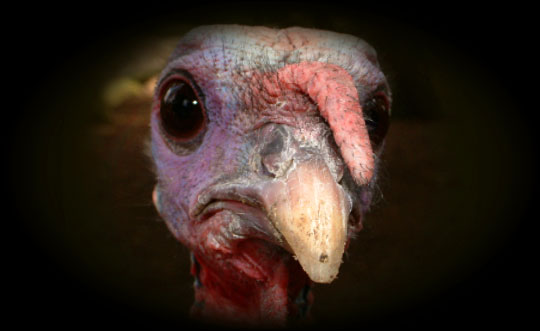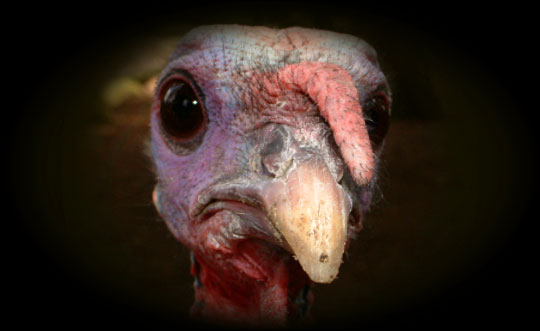In Checkout Line, Lou Bendrick cooks up answers to reader questions about how to green their food choices and other diet-related quandaries. Lettuce know what food worries keep you up at night.

Dear Checkout Line,
Let’s talk turkey. I want to green my Thanksgiving table, but have it be delicious, too. No more Butterball! But from there, should I mail order a heritage turkey, or buy a pastured one from a nearby farmer? Or buy an organic one from the supermarket? What sort of deliciousness/sustainability trade-offs are we talking about here?
All the best,
Tired of Odious Meat
Dear Tired,
Odious meat, indeed! The most commonly served Thanksgiving turkey, the Broad-Breasted White (BBW), has been called the “Barbie” of birds for good reason. This breed is a mutant with pneumatic breasts and no ability to procreate without serious help; it’s too top-heavy to get it on with Ken turkeys and must be artificially inseminated.
Choosing a different bird is a good start to greening your holiday table, but there are trade-offs when it comes to sustainability and deliciousness. So let’s take a look at pros and cons for the options you mentioned:
Mail-order Heritage Breed
What this is: Endangered breeds hailing from bygone eras that are being reintroduced thanks to groups such as Slow Food USA and the American Livestock Breeds Conservancy. These old breeds are gorgeous, hardy, and smart (I forgot to note that critics of the BBW say it is even dumber than Barbie).
Pros: You’re preserving history and genetic diversity with each mouthful. The guidelines for heritage breeds lend themselves to sustainability: These birds must do things that nature intended, such as roam around outside in the sunshine. They live longer than BBWs, mate naturally and have undeniably better lives than factory-farmed birds. For the specific guidelines, go here. These birds also take longer to grow big — 28 weeks as opposed to the 16 or so weeks it takes to fatten a BBW.
Although slower growth is more expensive for the farmer, it means that heritage breeds contain more fat, which adds flavor and moisture.
Cons: Heritage breed guidelines are not legally binding. If your turkey isn’t both certified organic and heritage breed, you’ll have to do your homework to find out exactly what the bird ate and how it was raised if you want to be certain you’re getting what you’re paying for. Also, mail order means that your bird traveled, and that increases Ye Olde Carbon Footprinte. Because producers tend to be small-scale farmers, you will likely have to order your bird far in advance.
Pastured Local Bird
What this is: A bird that was raised outside by a nearby farmer and thus ate a diet heavy on bugs and grass and relatively light on grain.
Pros: No long-haul travel. By supporting local producers, you support your farm community and preserve landscapes. By visiting the farm you can see for yourself if the birds are sustainably and humanely raised. Advocates say that birds that range around and eat lots of bugs are nutritionally superior to their confined counterparts (for example, higher in Omega 3 fatty acids). For more information on pastured meat, go to Eatwild.com. This is also a chance to get a fresh bird, which means that some coal-fired power plant somewhere won’t have to labor to freeze it. Also, pasture-based birds naturally deposit their manure into the soil, fertilizing the grass, thus not concentrating waste into fetid and toxic “lagoons,” like confined birds do.
Cons: Pastured birds move around freely, thus putting on more muscle. This can result in a tougher bird, though advocates refer to this as “firmness” and complain that non-pastured birds are mushy. Critics also say pastured birds taste gamy. Chances are that your local turkey farmer is small-scale, so you probably have to order this turkey well in advance. Pasture-raised guidelines aren’t enforceable, so if you a want a strictly pasture-raised bird, ask questions; your bird may be a heritage breed or a Barbie-like BBW.
Organic Bird from the Supermarket
What this is: Under USDA guidelines, these birds can be fed no antibiotics or growth enhancers, must eat organic feed, and must be given access to the outdoors.
Pros: USDA certification offers a certain level of reassurance. For those concerned about genetically modified feed, the organic label bans GMOs from these birds’ rations. Flavor/texture may be more consistent and familiar than in less conventionally raised birds.
Cons: Packaging + travel = more carbon. Plus, your bird may have come from a giant, industrial-sized producer (aka Big Turkey) and might not be traceable should there be a spooky recall. It may very well be a BBW. Access to the outdoors doesn’t mean it ever put a foot outside.
More generally, I’m sorry to report that a green choice doesn’t guarantee deliciousness. Last year, 24 testers from the Cook’s Illustrated magazine staff tasted eight turkeys, ranging from a Butterball to “unconventional” pastured, heritage-breed and organic turkeys. The results made me drop my triple-certified latté.
Cooks “highly recommended” two birds: a Kosher bird and a heritage-breed bird. That wasn’t the shocker: Following closely behind in the runner-up “recommended” category were two conventional injected-with-liquid self-basters, including the Butterball!
These bloated BBWs outranked four birds, including an organic, pasture-raised turkey. To read more about those results, go here.
Naturally, I had to call up Cook’s Illustrated and get to the bottom. Had those zany food testers been hitting the Beaujolais nouveau? I spoke with senior editor Lisa McManus, who explained that taste-test results can be influenced by what she calls the “Skippy Factor.” (That’s Skippy as in Skippy peanut butter.)
“People grew up with certain flavors, and whether or not you know better later in life, there are certain things that are sort of comforting or familiar,” McManus explained. “They do well mainly because of their familiarity. I think that’s a real factor with Butterball. People grew up on those birds and that’s what turkey tastes like to them. Sometimes it’s hard to get past that.”
Of course, flavor can also be affected by how you cook your bird. Thanksgiving is a holiday fraught with culinary peril for many reasons, including the mathematical challenge of thawing time, the pressure to cook for one’s mother-in-law, and an overall lack of skill in roasting an enormous bird.
“It makes for good stories when you screw it up,” says McManus. In that vein, my dear friend, Chip Blake bought a “recommended brand” organic bird from the supermarket last year. “It’s hard to describe its taste,” he said, “but imagine this: Buy a roll of any brand of paper towels. Remove plastic wrap. Lightly baste outside of roll in any brand of preprocessed turkey broth. Wrap roll tightly in aluminum foil and bake at 450 degrees for seventeen hours. Remove from oven and let cool, which won’t take long since the paper towels will contain no moisture that could retain heat or taste. Enjoy.”
Take heart, my dear green-leaning reader, if your consciously-chosen turkey ends up tasting like a roasted Barbie. “Buy a lot of good bread, make a big salad, make a good pumpkin pie and people will forgive you,” promises McManus whose favorite turkey roasting method can be found here. (Key concepts: brine and flip.) And remember, there’s always next year.
“We’ll try it again this year, since I don’t want to be a part of Corporate Turkey or their antibiotics or politics,” Blake told me. “But if we end up with baked paper towels again, we’ll probably switch to Chinese in 2009.”
Green appetit, and happy holidays.
Lou Bendrick


